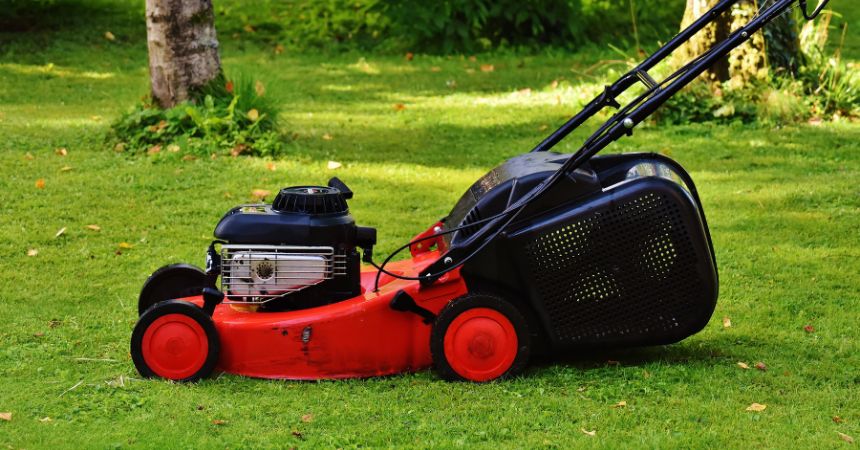How Often Should You Mow Your Lawn in Summer?
Dr. Mark Gaskell, a turfgrass specialist at the University of California Cooperative Extension, recommends grass mowing every 5–7 days during the growing season, but that’s a guideline, not a rule.
The exact number of times can change depending on the type of grass, how fast it grows, and the weather where you live.
Experts at the University of California’s Pest Management Division say that mowing your grass often throughout the growing season helps keep it healthy, keeps weeds from spreading, and makes the grass grow thicker.
In the hot summer season, grass tends to grow faster, especially if it gets enough water and fertilizer. Many homeowners try to mow less frequently to save time and money, but if you mow too rarely, you might cut off too much of the blade length at once, which can stress the plant and turn it brown.
Experts in landscape at Clemson University Extension say that you should never cut more than one-third of the grass blade height in one cut. For example, if you want the grass to be 3 inches tall, you need to mow it before it gets more than 4–4.5 inches tall.
Weekly grass cutting also makes photosynthesis work better. If you wait too long to mow, the grass may get tall and uneven, and it may start to shade itself, which weakens the field. On the other hand, mowing too early, which is called “scalping”, may hurt the top of the grass and expose the soil, making it more likely to get heat stress and weeds.
According to the University of Minnesota, cutting every 10–14 days at a taller height might be enough when it’s unusually hot and dry. Instead of closely following the calendar, keeping an eye on your lawn’s growth rate will help you keep it in good health and reduce the stress that the turf needs.

Understanding Oklahoma's Challenging Summer Climate
Oklahoma summers bring temperatures that regularly soar to 90°F and often exceed 100°F. Oklahoma has a humid subtropical climate, which means that summers are hot and humid, with periods of drought and strong storms. The speeds at which your grass grows and how often you should mow it are greatly affected by these factors.
Most lawns in the Tulsa area are made up of warm-season grasses such as:
- Bermuda Grass: Grows aggressively in heat and full sun.
- Zoysia Grass: Dense and tolerant, slower-growing than Bermuda.
- St. Augustine Grass: Shade-tolerant but sensitive to cold and drought.
- Tall Fescue: Cool-season grass commonly utilized in shaded areas.
The fastest growth for these grasses happens in late spring through August. As temperatures often rise above 90°F, grass may grow quickly if it gets enough water, or it may go dormant in dry and hot conditions.
Residential vs. Commercial Property Considerations
How Often Should a Residential Property Owner Mow Their Lawn?
Homeowners should plan on weekly mowing during active growing seasons, adjusting frequency based on actual growth rather than calendar dates.
Well-fertilized and irrigated lawns may require cutting every 4–5 days during peak periods. Raise mower height slightly during extreme heat to help grass retain moisture and protect root systems.
Avoid evening mowing when dew formation can promote fungal diseases. Shaded areas typically grow slower and need less frequent attention than sunny spots.
How Often Should a Commercial Property Owner Mow Their Lawn?
Commercial properties generally require mowing every 1–2 weeks during the growing season, with frequency determined by aesthetic standards and grass type.
Spring’s rapid growth often demands weekly cutting, while summer heat stress may allow stretching intervals to every 10 days. Fall mowing can extend to every 2–3 weeks as growth slows.
Professional landscapers typically adjust schedules based on property visibility, foot traffic, and maintenance budgets rather than following residential-style weekly routines.

Weekly vs. Biweekly Lawn Mowing: What’s Better for Tulsa Lawns?
Research consistently supports weekly mowing over biweekly schedules for Tulsa’s climate conditions. Weekly cutting prevents the removal of excess blade material that stresses plants and creates brown patches.
Biweekly lawn mowing often violates the one-third rule, forcing you to cut too much at once. This shock weakens grass, reduces photosynthesis efficiency, and makes lawns vulnerable to heat damage.
Weekly schedules also produce manageable clipping volumes that decompose quickly and return nutrients to the soil. Longer intervals create heavy clipping loads that may smother grass or require removal.
Most lawn care specialists agree that consistent weekly mowing promotes thicker growth patterns and improves the lawn’s ability to retain moisture during stress periods.
How Often Should You Mow During Tulsa Heatwaves?
When temperatures exceed 100°F for extended periods, you should only mow every 10–14 days, or when the grass is at least 1.5 inches tall. According to research from the Oklahoma State University Extension, you should let your grass grow 3–4 inches taller during really hot weather.
Longer blades of grass shade the soil, keep moisture in, and protect roots from stress. When it’s hot outside, mowing too much may weaken the grass, slow down recovery, and make it more likely to be damaged by drought. So the best thing to do is to do less until the weather cools down.
How Often Should You Mow Newly Seeded Lawns?
For a freshly seeded lawn, you should wait until the grass is approximately 3–4 inches tall, which usually happens 4–8 weeks after seeding. After that, you should follow the one-third rule.
It takes time for newly developed grass to grow roots and make its leaves strong. Experts at the University of California say you should wait up to two months before mowing for the first time to make sure the grass has established.
Newly seeded lawns always require some patience. Let the grass grow tall and strong, and then cut it carefully with a short trim to help it take root and grow.
What Are Common Mowing Frequency Mistakes Homeowners Make?
Even with good intentions, many homeowners in Tulsa damage their lawns simply by mowing at the wrong intervals or ignoring seasonal growth patterns.
- Sticking to a fixed schedule: Mowing every week regardless of growth ignores seasonal changes and can harm grass during slow-growth periods.
- Cutting too often in heatwaves or drought: Frequent mowing in stressful conditions weakens root systems and makes lawns more vulnerable.
- Waiting too long between mows: Letting grass grow too tall forces you to remove too much at once, which can scalp the lawn and reduce photosynthesis.
- Ignoring the “one-third rule”: Removing more than one-third of the grass blade at a time stresses the plant and slows recovery.
- Not adjusting for seasonal growth rates: Failing to adapt mowing frequency to current conditions, such as faster spring growth or slower summer growth, leads to inconsistent lawn health.
What Are the Signs You’re Mowing Your Lawn Too Often?
The signs you’re mowing your lawn too often include brown or burned-out patches, weak or sparse growth, an increase in weeds, and visible tire tracks or ruts from your mower. If you find yourself cutting the grass several times a week, noticing thinning patches, or your lawn starts turning yellow or brown despite regular care, you might be over-mowing your lawn.
Over-mowing in summer heat or during drought removes too much leaf surface, reducing the grass’s ability to photosynthesize, retain moisture, and stay resilient. This stress makes your lawn unhealthy and vulnerable to pests, diseases, and weed invasion.
How Grass Type Affects Mowing Frequency in Oklahoma?
The kind of grass you have will affect how quickly it grows, how short you can trim it, and how frequently you need to cut it in the summer.
The University of Arkansas Agriculture Division advises mowing Bermuda grass frequently enough so that no more than one-third of the blade is removed at a time, maintaining a height between 1.5 and 2.5 inches.
They also recommends cutting Zoysia grass before it exceeds 1.5– 2.5 inches in height. This early-season mowing helps remove surplus dormant material and sets the desired mowing height for the rest of the year. Grass clippings can be left on the lawn to recycle nutrients, unless they form unsightly clumps.
Texas A&M University notes that if the ideal mowing height for St. Augustine grass is 2 inches, you should plan to mow when it reaches around 3 inches. Doing so helps prevent scalping and reduces the risk of significant damage that could harm both the look and health of the turf.
You should avoid removing more than one-third of the total green canopy height at any one time.
Identify your grass type and tailor your mowing routine accordingly. A “one-size-fits-all” approach rarely works in Oklahoma’s climate.
How to Use Smart Irrigation with Your Mowing Schedule?
To make the most of smart irrigation with your mowing schedule, water your lawn early in the morning (between 4 and 9 a.m.) to keep the water from evaporating and let the grass dry before you mow. If you mow in the morning, water the night before. If you water in the morning, wait until the afternoon when the grass is dry to mow.
To help roots grow strong, water thoroughly but less often, around 1–1.5 inches each week. A smart irrigation controller can help you automatically irrigate your lawn depending on the weather and soil conditions. This keeps your grass from getting too much water and makes it healthier.
How Often Should You Mow Your Lawn in Tulsa, Oklahoma?
Weekly mowing works best for most Tulsa lawns during summer months. During peak growth periods in late spring and early summer, you might need to mow every 4–5 days to maintain proper height.
The critical rule governing all mowing decisions is the “one-third principle”—never remove more than one-third of the grass blade length in a single cutting. Clemson University Extension experts stress that violating this rule stresses plants and weakens root systems.
For example, if you want 3-inch tall grass, mow before it exceeds 4 to 4.5 inches. This approach maintains the leaf surface area needed for photosynthesis while preventing the grass from shading itself.
During drought conditions, the University of Minnesota suggests extending intervals to 10–14 days. Monitor growth rates rather than following rigid calendar schedules to reduce turf stress.
General Guidelines for a Healthy Lawn for Tulsa Summer
For a healthy lawn in Tulsa summers, follow this recommended mowing schedule:
- Mow your lawn every 5–7 days during summer.
- Set mower height to 3–4 inches to reduce heat stress on grass.
- During dry or hot spells, extend mowing intervals to avoid over-stressing the lawn.
- Follow the one-third rule: never cut more than one-third of the grass blade’s length at once.
- Avoid cutting grass during the hottest part of the day; mow early morning or late afternoon.
- Adjust watering to support grass health alongside mowing practices.
